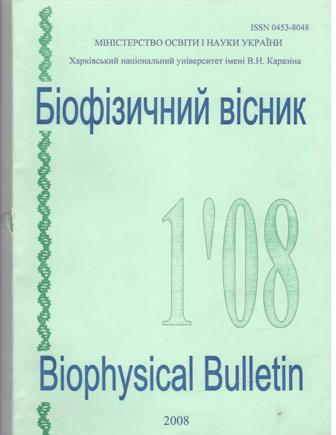Spectral behavior of amyloid-specific dyes in protein-lipid systems. II. Congo Red interactions with hemoglobiШ
Abstract
A number of so-called conformational diseases including neurological disorders (Parkinson's, Alzheimer's, and Huntington's diseases), type II diabetes, spongiform encephalopathies, systemic amyloidosis, etc., are associated with the deposition in the tissue of highly ordered aggregates of specific proteins. Amyloid fibrils are usually detected by several techniques including Thioflavin T fluorescence, Congo Red (CR) birefringence of the spectrophotometric assay, electron microscopy, etc. However, the application of amyloid-specific agents such as CR to amyloid detection may be hampered by the dyeability to associate not only with fibrillar structures but also with monomeric protein species. In view of this reasoning, the present study was directed toward the examination of the interactions between CR and hemoglobin (Hb), the protein with well-characterized structure and physicochemical properties. The binding of CR to native and denatured Hb was studied using the absorption spectroscopy technique. The differential absorption spectrum of CR associated with denatured protein was found to exhibit maximum close to that characteristic of fibrillar structures (545 nm), thereby providing arguments in favor of Hb fibrillization. The formation of CR complexes with native Hb was followed by the long-wavelength shift (-10 nm) of absorption maxima being indicative of the probe transfer to the environment of lower polarity. Based on analysis of Hb crystal structure the tentative location of CR in i.he protein molecule has been identified. The most probable dye-binding site was assumed to involve the hydrophobic cavity between Lysl6 and Lys60 serving as anchors for two negatively charged CR sulfonic groups. Quantitative parameters of CR complexation with native Hb - association constant (Kb) and a number of binding sites («) - were determined by analyzing the dependencies of dye absorbance changes upon varying protein concentration. Approximation of experimental dependencies by Langmuir binding model yielded the values of Kh and n ca. 2.6* 105 M"1 and 1.4, respectively. For thermally denatured Hb, the shape of the CR binding curve was revealed to change from Langmuir-like to sigmoidal. Simulation results showed that such behavior of the binding curve is characteristic of preferential dye association with aggregated protein species.
Downloads
References
2. M.R.H. Krebs, E.H.C. Bromley, A.M. Donald // J. Struct. Biol. 2005. 149. P. 30-37.
3. L.C. Serpell // Biochim. Biophys. Acta. 2000. V. 1502. P. 16-30.
4. O.S. Makin // Proc. Natl. Acad. Sci. 2005. V. 102. P. 315-320.
5. V. Uversky and A. Fink // Biochim. Biophys. Acta. 2004. V. 1698. P. 131-153.
6. D.B. Carter and K.C. Chou // Neurobiol. Aging. 1998. V. 19. P. 37-40.
Authors who publish with this journal agree to the following terms:
- Authors retain copyright and grant the journal right of first publication with the work simultaneously licensed under a Creative Commons Attribution License that allows others to share the work with an acknowledgement of the work's authorship and initial publication in this journal.
- Authors are able to enter into separate, additional contractual arrangements for the non-exclusive distribution of the journal's published version of the work (e.g., post it to an institutional repository or publish it in a book), with an acknowledgement of its initial publication in this journal.
- Authors are permitted and encouraged to post their work online (e.g., in institutional repositories or on their website) prior to and during the submission process, as it can lead to productive exchanges, as well as earlier and greater citation of published work (See The Effect of Open Access).





